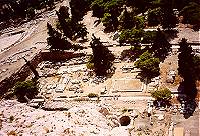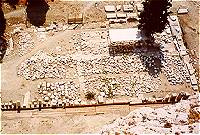ATHENS
Acropolis
Athena Nike
Erechtheum
Parthenon
Propylaia
Acropolis
Museum
South
Slope overview
South Slope lecture
Pnyx
Areopagus
Philopappos
Hill
Agora
Temple
of Olympian Zeus
and Arch of Hadrian
Keramikos
Roman Agora
ATTICA
Brauron
Thorikos
Sounion
Oropos
Marathon
Eleusis
Aigosthena/
Eleutherai
Daphni
Piraeus
MESSENIA
Pylos
Voidokilia
Methoni
Messene
CORINTHIA
Perachora
Corinth
Acrocorinth
Diolkos/Canal
Nemea
Isthmia
BOEOTIA
Thebes
Chaironeia
Orchomenos
Gla
Osios
Loukas
ARGOLID
Epidavros
Nauplion
Mycenae
Argos
Tiryns
ARCADIA
Megalopolis
Overview
Tegea
LACONIA
Mistras
Sparta
Monemvasia
ACHAEA
Kalavrita
NORTHERN
GREECE
scenery
Mount
Olympos
DELPHI
Thermopylae
Naupaktos
Mieza
Edessa
Vergina
Pella
Thessaloniki
ELEIA
Olympia
Chlemoutsi
SARONIC GULF ISLANDS
Aegina
Poros
Hydra
Spetses
CYCLADIC ISLANDS
Santorini
Delos
CRETE
Cnossos
Phaistos
Zakros
|
 |
 Dr. J's
Illustrated
South Slope of the
Acropolis Dr. J's
Illustrated
South Slope of the
Acropolis
The Theater of Dionysus
For an
overview of Greek theater and definitions of Greek theater terminology,
please visit Dr.
J's Illustrated Greek Theater Page
The building of the
Theater of Dionysus was apparently precipitated by the collapse of wooden bleachers in the
agora, where dramatic and musical competitions were held up until the late sixth century
BC. The decision was made to build a new theater on the south slope of the Acropolis next
to the shrine of Dionysus
Eleutherios (a cult transplanted from Eleutherai in Boeotia, but nobody is sure exactly
when). The first win on record belongs to Thespis (534 BC), from that time on known as the
Father of classical Theater. The early 6th century theater was composed of wooden seats
surrounding a circular orchestra of beaten earth. Theater-goers worshipped at the nearby
shrine of Dionysus. Sometime in the
5th century during the time of Pericles and the tragedians, a wooden skene (stage area)
was added. In the 430,'s Alkamenes made a chyselephantine cult statue of Dionysus for his
temple. Walls were built to support the east and west sides of the theater and a stoa was
connected to the wooden set. But the theater that has survived to our time was designed
between 342 and 326 BC, when the archon Lycurgus commissioned an extensive reconstruction
in stone and marble including the following improvements: of Dionysus
Eleutherios (a cult transplanted from Eleutherai in Boeotia, but nobody is sure exactly
when). The first win on record belongs to Thespis (534 BC), from that time on known as the
Father of classical Theater. The early 6th century theater was composed of wooden seats
surrounding a circular orchestra of beaten earth. Theater-goers worshipped at the nearby
shrine of Dionysus. Sometime in the
5th century during the time of Pericles and the tragedians, a wooden skene (stage area)
was added. In the 430,'s Alkamenes made a chyselephantine cult statue of Dionysus for his
temple. Walls were built to support the east and west sides of the theater and a stoa was
connected to the wooden set. But the theater that has survived to our time was designed
between 342 and 326 BC, when the archon Lycurgus commissioned an extensive reconstruction
in stone and marble including the following improvements: |
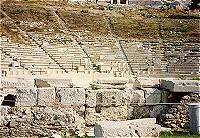 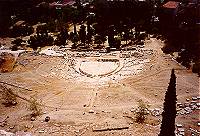 Lycurgus
expanded the number of seats to 17,000 (even though Plato suggests the figure 30,000 in
the Symposium) Of the 64 tiers, about 20 survive. A diazoma (division between
upper and lower seats) was added also. At this time, the wooden seats were Lycurgus
expanded the number of seats to 17,000 (even though Plato suggests the figure 30,000 in
the Symposium) Of the 64 tiers, about 20 survive. A diazoma (division between
upper and lower seats) was added also. At this time, the wooden seats were replaced with the Piraeus limestone visitors still scamper over today.
The ingenious design of the seats allows a 13-inch trough in which spectators can rest
their feet without discomfiting those in the row below (right). replaced with the Piraeus limestone visitors still scamper over today.
The ingenious design of the seats allows a 13-inch trough in which spectators can rest
their feet without discomfiting those in the row below (right). |
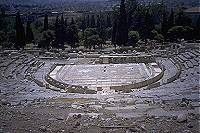 Lycurgus
replaced the portable, wooden sets with a permanent stone skene, complete with
side-entryways (paraskenia) and paths (paradoi); he also built a new Temple of Dionysus
for the chryselephantine statue made by Alkamenes. At this time, when official copies of
their works were first entered into the public record, portraits of Aeschylus, Sophocles,
Euripides and Aristophanes were displayed in the theater as well. A base with Menander's
name on it can be found in situ, but this dates to a later era. Lycurgus
replaced the portable, wooden sets with a permanent stone skene, complete with
side-entryways (paraskenia) and paths (paradoi); he also built a new Temple of Dionysus
for the chryselephantine statue made by Alkamenes. At this time, when official copies of
their works were first entered into the public record, portraits of Aeschylus, Sophocles,
Euripides and Aristophanes were displayed in the theater as well. A base with Menander's
name on it can be found in situ, but this dates to a later era. |
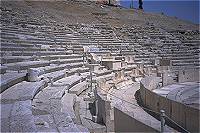
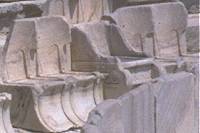
|
Also
added at Lycurgus' time was a row of 67 high-backed chairs of Pendelic marble for
judges and dignitaries (upper left). Each seat is inscribed with the name of the
individual for whom it was reserved (example, upper right). The elaborately carved throne
in the center of the first row (below, left) belonged to the Priest of Dionysus - who
officiated
over the event - and lies in direct line with the thymele, or altar of the god, in the center of the
orchestra. The throne of Hadrian sat on the stone plinth immediately behind the priest.
This other remarkably preserved throne (right) is of unknown ownership but sports the same
elaborately carved lion-claw feet as the one belonging to the Priest of Dionysus. |


|
|
The Hellenistic Era
didn't see too many changes to this theater, but in the 3rd and 2nd centuries BC, a raised
stage with a stone proskenion was added, as well as a second story for the skene. |
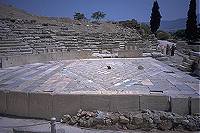 The
Roman Era saw some major changes to the structure, such as a marble barrier to protect the
audience during gladiatorial exhibitions (AD 1st). Like most Greek structures of civic
importance, the Romans rededicated the theater, in this instance in the names of Dionysus
and the Emperor Nero (in much the same way as they rededicated the theater at Delphi to
Nero). The
Roman Era saw some major changes to the structure, such as a marble barrier to protect the
audience during gladiatorial exhibitions (AD 1st). Like most Greek structures of civic
importance, the Romans rededicated the theater, in this instance in the names of Dionysus
and the Emperor Nero (in much the same way as they rededicated the theater at Delphi to
Nero). |
|
|
The
Bema of Phaedrus has been dated to the 2nd century AD: the ophot on the
left (below)would have been the front of the Roman stage, and the reliefs
(below, right)depict stories from the life of Dionysus. One shows the
depiction of the god's enthronement in the theater. The Acropolis is seen
in the background. The crouching figures in the middle are particularly
appropriate to a relief dedicated to Dionysus (close-up, below center).
Called Sileni after Silenus, Dionysus' mentor, they bear witness to the
drunken revelry most associated with the worship of Dionysus, god of the
vine. |
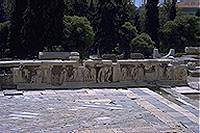 |
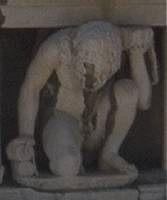 |
  |
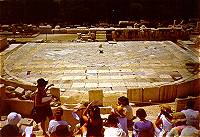 In the 4th century AD, Romans put down the marble
slabs we see today in the orchestra to make it watertight so that they could perform
naumachia (brutal sea battles in which gladiators in boats hacked at each other until the
water ran red with their blood for the entertainment of the spectators). Even the
beautiful sculptures of the Bema (above) were plastered over with cement to make the
entire area water-tight. In the 4th century AD, Romans put down the marble
slabs we see today in the orchestra to make it watertight so that they could perform
naumachia (brutal sea battles in which gladiators in boats hacked at each other until the
water ran red with their blood for the entertainment of the spectators). Even the
beautiful sculptures of the Bema (above) were plastered over with cement to make the
entire area water-tight.
Tour some
VERY cool virtual reality models of the Theater of Dionysus in its various stages of
evolution from the fifth century BC to Roman times |
Choregic
Monument of Thrasyllos |
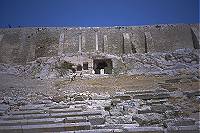 This
monument, at the very top of the theatron of the Theater of Dionysus, was initially
erected in 320 BC by Thrasyllos in front of the cave he dedicated to Dionysus. 50 years
later, the monument was enlarged by his son, Thrasykles, in celebration of This
monument, at the very top of the theatron of the Theater of Dionysus, was initially
erected in 320 BC by Thrasyllos in front of the cave he dedicated to Dionysus. 50 years
later, the monument was enlarged by his son, Thrasykles, in celebration of similar choregic victories. The monument
was much more elaborate that the surviving parts suggest, and even these Corinthian
columns once supported votive tripods. The picture on the right was taken from the Wall of
Cimon, a defensive wall surrounding the acropolis built after the Persian Invasion. That
cave once dedicated to Dionysus sported a painting of Apollo and Artemis
killing Niobe's children when Pausanias passed through Athens in the 2nd
century AD (1.21.5), and it is now a Christian shrine. similar choregic victories. The monument
was much more elaborate that the surviving parts suggest, and even these Corinthian
columns once supported votive tripods. The picture on the right was taken from the Wall of
Cimon, a defensive wall surrounding the acropolis built after the Persian Invasion. That
cave once dedicated to Dionysus sported a painting of Apollo and Artemis
killing Niobe's children when Pausanias passed through Athens in the 2nd
century AD (1.21.5), and it is now a Christian shrine.
Stoa
of Eumenes
Odeum of Herodes Atticus |
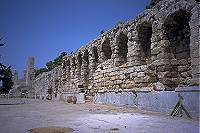  The Stoa of Eumenes is what remains of the
colonnade built by Eumenes II, King of Pergamon (197-159 BC). It serves as a magnificent
backdrop for the Odeum of Herodes Atticus, built in AD 160. The Roman writer Vitruvius
says that the stoa served as shelter for spectators in inclement weather as well as
storage space for scenery and sets. It is a typical Roman theater design, seating 5-6000:
note that while Greek theaters lean into hills and become one with their environments,
Roman theaters depend on
man-made structures for support and backdrop. Amazingly, this auditorium was roofed in
antiquity. The building was destroyed by the
Hirullians in AD 267. The
entire theater was refurbished in the 1950's and is today used for theatrical performances
during the summer Athens Festival. The Stoa of Eumenes is what remains of the
colonnade built by Eumenes II, King of Pergamon (197-159 BC). It serves as a magnificent
backdrop for the Odeum of Herodes Atticus, built in AD 160. The Roman writer Vitruvius
says that the stoa served as shelter for spectators in inclement weather as well as
storage space for scenery and sets. It is a typical Roman theater design, seating 5-6000:
note that while Greek theaters lean into hills and become one with their environments,
Roman theaters depend on
man-made structures for support and backdrop. Amazingly, this auditorium was roofed in
antiquity. The building was destroyed by the
Hirullians in AD 267. The
entire theater was refurbished in the 1950's and is today used for theatrical performances
during the summer Athens Festival.
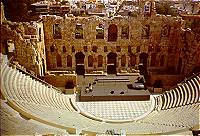
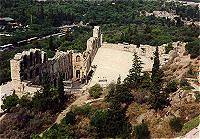 Herodes Atticus was a wealthy Athenian who
spent his money on public works, among them this Odeum (or Odeion) in Athens for musical
performances and the stadium at Delphi; he officiated as the Priest of Dionysus at the
Panathenaic Festivals, and he was a sophist who counted Marcus Aurelius among his
students. He has a generally spotless record with one exception. As the story goes,
Herodes built this magnificent structure in memory of Herodes Atticus was a wealthy Athenian who
spent his money on public works, among them this Odeum (or Odeion) in Athens for musical
performances and the stadium at Delphi; he officiated as the Priest of Dionysus at the
Panathenaic Festivals, and he was a sophist who counted Marcus Aurelius among his
students. He has a generally spotless record with one exception. As the story goes,
Herodes built this magnificent structure in memory of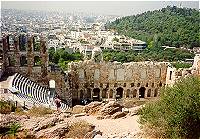 his dear departed wife, Regilla. But a story circulated that he
had in fact killed her by kicking her in the abdomen when she was pregnant - but since he
was able to point to the great expense he incurred building this memorial as proof of his
love for her, he was never charged with a crime... his dear departed wife, Regilla. But a story circulated that he
had in fact killed her by kicking her in the abdomen when she was pregnant - but since he
was able to point to the great expense he incurred building this memorial as proof of his
love for her, he was never charged with a crime...
Temple of
Asklepios Building Complex
|
|
|
|
|
copyright
2001 Janice
Siegel,
All Rights Reserved
send comments to: Janice Siegel (jfsiege@ilstu.edu)
date this page was edited last:
08/02/2005
the URL
of this page:
copyright
2001 Janice
Siegel,
All Rights Reserved
send comments to: Janice Siegel (jfsiege@ilstu.edu)
date this page was edited last:
08/02/2005
the URL
of this page:
|























